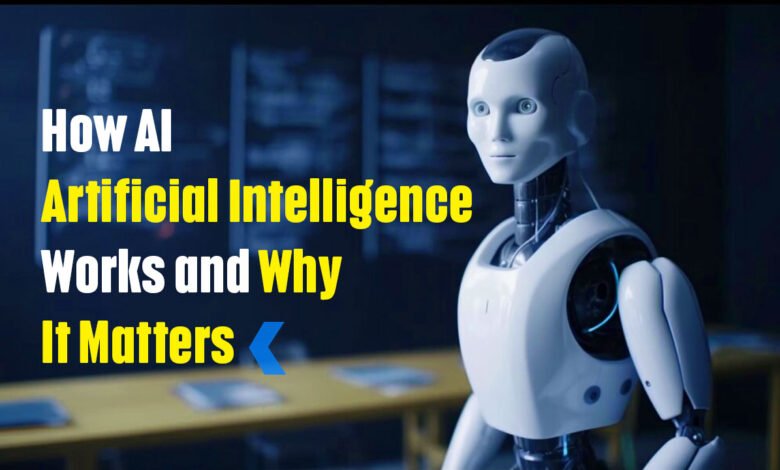How Artificial Intelligence Works and Why It Matters in 2024

Artificial Intelligence (AI) is becoming a major part of our lives, from how businesses work to how we shop and even how we communicate. In 2024, AI is growing fast, and understanding how it works can help you stay ahead. Whether you’re curious about AI for personal use or you’re a business owner wanting to keep up with trends, this guide will explain how AI works and why it’s important today.
Let’s dive into what AI is, how it works, and the many ways it’s being used in 2024.
What is Artificial Intelligence?
Artificial Intelligence (AI) refers to machines and computers that can perform tasks that usually need human intelligence. These include things like understanding language, recognizing objects in images, making decisions, and even learning from experience. Think of AI as a smart tool that helps computers act more like humans.
There are two main types of AI:
- Narrow AI (Weak AI): This is AI that’s designed to do specific tasks, like Siri answering your questions or Netflix recommending movies. Narrow AI is great at what it does but can’t do anything outside its programmed task.
- General AI (Strong AI): This type of AI, also called Artificial General Intelligence (AGI), doesn’t exist yet. If developed, it would be able to learn and think like a human and perform any task that a person can.
How Does AI Work?
AI works by using large amounts of data and learning from it. The two main ways AI learns are through Machine Learning (ML) and Deep Learning.
Machine Learning
In simple terms, machine learning allows computers to learn from data without needing to be manually programmed for every task. For example, if you show a machine learning system thousands of pictures of cats, it can learn to identify a cat in new pictures based on patterns it has seen before.
-
- Supervised Learning: Here, the AI is trained using labeled data. For instance, you give it images labeled as “cats” or “dogs,” and it learns to tell them apart.
- Unsupervised Learning: The AI looks at data that isn’t labeled and tries to find patterns on its own, like grouping similar things together.
- Reinforcement Learning: The AI learns through trial and error, making decisions and improving over time based on feedback.
Deep Learning
This is a more advanced form of machine learning. It uses layers of networks, called neural networks that mimic how the human brain works. Deep learning helps AI perform complex tasks like recognizing faces, understanding speech, and even driving cars. For representative, Tesla’s self-driving technology depends on deep learning to navigate roads, detect obstacles, and make real-time decisions.
Why Does AI Matter in 2024?
AI is transforming industries and making everyday tasks easier and more efficient. Here’s why AI is so important today:
Automation:
AI can automate tasks that used to be done by humans. For example, chatbots can handle customer service questions, and AI systems can manage inventory in stores. This helps businesses save time and money.
Smarter Decision-Making:
AI can process huge amounts of data quickly. This helps businesses make better decisions, like predicting what customers will want to buy or spotting trends in the market.
Healthcare Innovations:
AI is making healthcare smarter by helping doctors diagnose diseases faster and more accurately. AI tools can scan medical images and identify potential health issues that might be missed by the human eye.
Everyday Convenience:
From personalized shopping recommendations to voice assistants like Alexa, AI is improving our daily lives by making things more convenient and efficient.
Creative Tools:
AI is also being used in creative fields. For example, AI can help artists and designers by generating artwork, music, or even writing text based on prompts.
Key Applications of AI in 2024
AI is being used in many different areas. Let’s look at some key applications:
- Healthcare: AI is helping doctors and researchers analyze patient data to improve treatment plans. It’s also being used in medical imaging to detect diseases like cancer at an early stage.
- Finance: In banking, AI is used to detect fraud, manage risks, and even help customers make financial decisions through AI-powered tools.
- Retail and E-Commerce: Online shopping platforms use AI to recommend products based on what you’ve bought or searched for before. AI also helps businesses manage stock levels and predict what items will be popular.
- Transportation: AI is driving the development of self-driving cars. It’s also being used to optimize routes and manage traffic flow in cities.
- Cybersecurity: AI helps keep businesses safe by detecting unusual activities that might be signs of cyberattacks. It’s like having a security guard that never sleeps!
- Education: AI-powered tools are changing how students learn. For example, AI can personalize lessons for students based on their learning style, helping them improve in subjects where they struggle.
Benefits of AI
AI offers many advantages that make it an attractive tool for businesses and individuals. Here are some of the key benefits:
- Increased Efficiency: AI can do things faster than humans, from processing data to answering customer questions. This increases productivity and reduces the time spent on routine tasks.
- 24/7 Availability: Unlike humans, AI systems don’t need breaks or sleep. AI-powered tools like chatbots can provide support or process information around the clock.
- Less Human Error: AI can be more accurate than humans, especially when it comes to tasks that require attention to detail, like analyzing data or diagnosing diseases.
- Scalability: AI can handle large amounts of data and tasks. For example, an AI-powered system can analyze millions of pieces of data in minutes, which would take a human much longer.
Challenges and Risks of AI
While AI has many benefits, it also comes with challenges:
- Privacy and Security Concerns: Since AI uses a lot of data, there are concerns about how this data is handled and whether it’s kept secure. Data breaches and misuse of information are real risks that need to be managed.
- Job Displacement: As AI takes over more tasks, some jobs may be at risk of being replaced by machines. While AI will create new jobs, it could also lead to unemployment in certain fields.
- Bias in AI Systems: AI systems can sometimes be biased, especially if the data they’re trained on is biased. This can lead to unfair decisions or outcomes, especially in areas like hiring or law enforcement.
- High Costs: Developing and maintaining AI systems can be expensive, particularly for small businesses. It requires investment in infrastructure, training, and ongoing support.
The Future of AI
AI is constantly evolving, and its future is full of exciting possibilities. Here are some trends to watch for:
- Artificial General Intelligence (AGI): While AGI doesn’t exist yet, researchers are working on developing AI systems that can think and learn like humans.
- Generative AI: Tools like ChatGPT and DALL-E are examples of generative AI, which can create text, images, and even music. We’re likely to see more of these creative AI tools in the future, helping artists, writers, and musicians bring their ideas to life.
- AI in Space: AI is also being used in space exploration to help analyze data and assist with missions to other planets.
Conclusion
Artificial Intelligence is transforming the world, from how businesses operate to our daily routines. In 2024, AI is more important than ever, helping automate tasks, make better decisions, and improve industries like healthcare, finance, and education. We hope this article has been helpful! Be sure to check out our related articles for more insights.
More to Explore: How to Launch and Grow a Small Business in 2024 – Vision to Success

